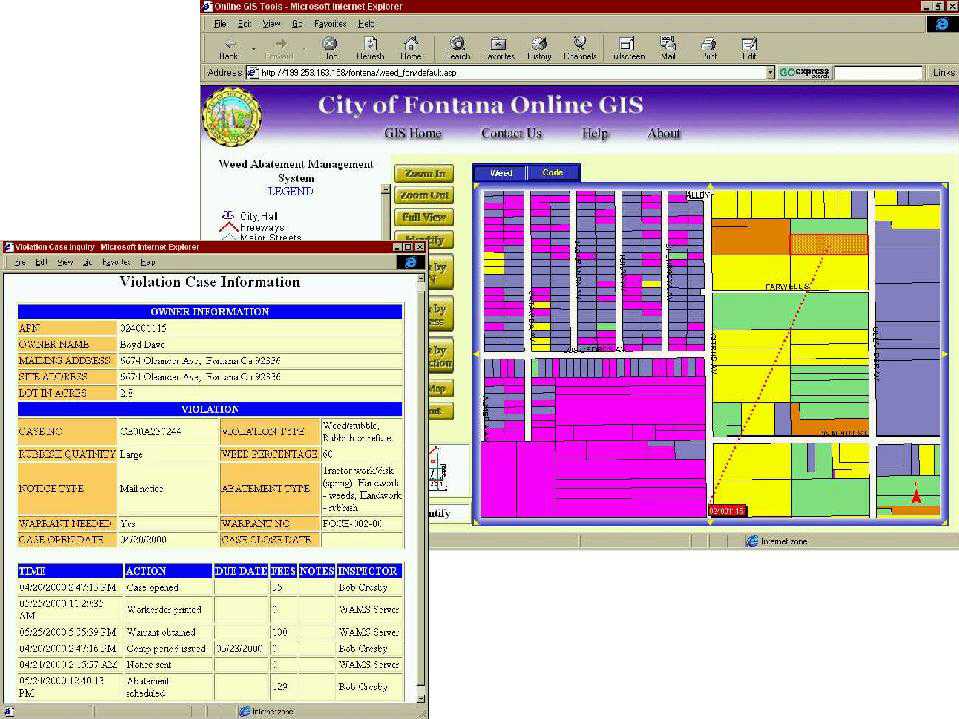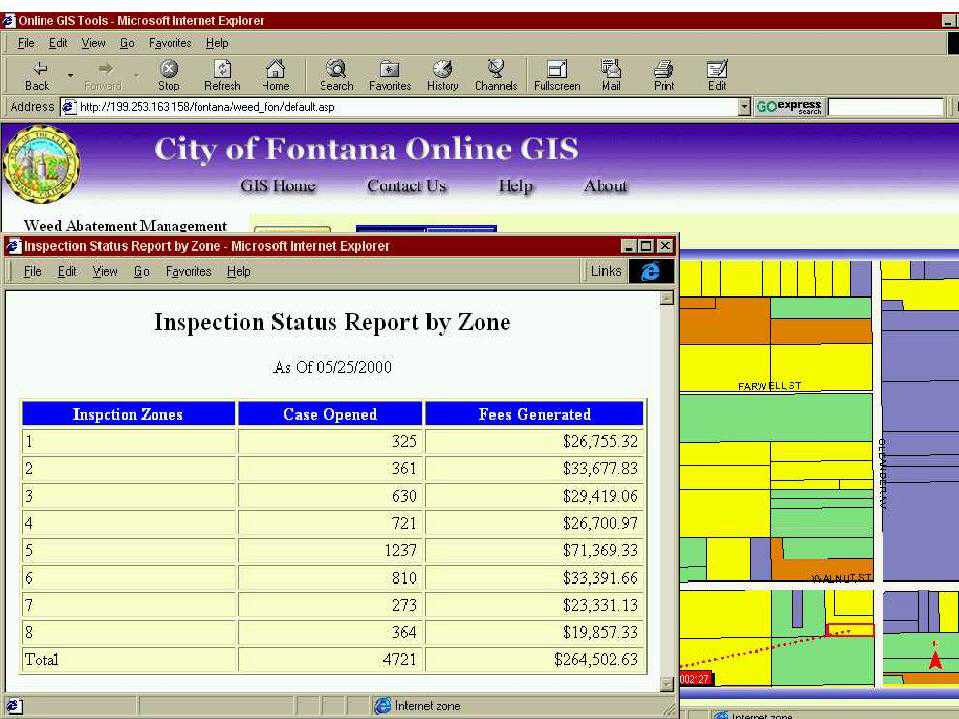Fontana's Weed Identification and Removal Management System
Douglas Henstridge (Psomas)
Bob Gilpatrick (City of Fontana)
Abstract
The system is designed to automate the semi annual inspection and determination of
properties in need of weed and trash clean up. The system supports three distinct business
activities within the weed abatement process, these include the field inspection and
identification, integration with the city's code enforcement system, and the automated
notification and clean-up assignment process. Once implemented the system has increased
the effectiveness of the process, significantly reduced the amount of time required, and
increased the overall accuracy. The system was built using MapObjects 2.0, MapObjects IMS
and Visual Basic.
Fontana's Weed Identification and Removal Management System
Introduction
 |
The Community Improvement Division of the City of Fontana, located
approximately 50 miles east of Los Angeles, is working with Psomas to implement an
automated system to support the semi-annual weed abatement process. In the Fall of 1999
the City reacquired jurisdiction for weed abatement. The City’s goal is to take the
weed abatement process beyond the traditional fire prevention activities, and also use the
process to enhance the visual aesthetics of the community. "We wanted to make the
process much more detailed. We wanted to go further than the county did," said Ted
Porlas, Community Improvement Manager. While the City was negotiating the return of
jurisdiction with the county, Community Improvement staff was working to define the weed
abatement process to be used by the city. This was to include drive-by inspections of all
of the approximately 35,000 parcels in the city, a case tracking methodology to
distinguish weed abatement violations from more traditional code enforcement activities,
and a fee billing and accounting system to support the process. Since the entire process
was new, the City chose to implement a fully automated solution to support the program
from day one. It was thought the learning curve would be about the same, but the automated
approach would reduce the time need for inspection and violation process, thus allowing
code enforcement inspectors to perform both weed abatement and daily code enforcement
activities concurrently. |
Once the City decided to pursue a fully automated system, the services of Psomas,
Riverside, CA were retained to work with Community Improvement staff to build a system to
meet all of the programs business and functional needs.
City’s Goals and Objectives
The primary objective of the city in implementing the automated weed abatement system
was to increase the efficiency of the process, reduce potential errors, and maximize the
fee revenues from the program to support other code enforcement activities. The following
goals support this primary objective:
- Develop the capability for the city staff to automate the identification, notification
and fee assessment for properties not in compliance with weed removal requirements
- Automate the development of display and presentation materials for demonstrating
identified violations
- Automate the production of reports and maps regarding weed abatement activities
Key Challenges for the Program
Once the decision was made to proceed with the development of a City weed abatement
process, several key challenges were identified, which needed to be overcome. These
challenges were centered on the limited understanding within the Division for the new weed
abatement process, and the short program development and implementation time frame.
For most of the City’s code enforcement staff the semi-annual weed abatement
process was new. While all of the inspectors had experience in more traditional complaint
driven code enforcement inspections, most had never participated in such a structured weed
abatement program. Additionally, many of the code enforcement staff had only limited
experience in working with technology assisted code enforcement activities. This meant
that special consideration would be given to both the field inspection process training,
as well as training with the new computer-based system. It also meant that the GIS-based
program would need to be as easy to use as possible. Each processing step in the system
must be intuitive, and the on-line forms should be easy to read, and have the same look
and feel as the more familiar paper versions.
Additionally, the short development and implementation time frame, present a major
challenge to the overall program. The program was approved by the City Council in early
December 1999, yet needed to be fully operational by April 3rd 2000. This left
little room for error or extended review and testing periods that would normally be
integrated into the development of what turned out to be a complex system. It also
required that City staff work very closely with the Psomas development team to ensure
efficient use of time during design and development, and a successful first season of use.
Developing the Solution
Immediately following council approval for the weed abatement system, the City’s
code enforcement staff and Psomas got together to define the system requirements and
automation needs for the program. Initially, the Weed Abatement Management System (WAMS)
must provide capabilities for the following activities:

- Access to parcel and property information
- Initial inspections and case tracking
- Reinspection flagging and inspection support
- Issuance of violation notices
- Issuance of warrants
- Issuance of weed abatement work orders
- Calculation of costs and data transfer to City's billing system
- Mapping of violations and case reporting
The development of WAMS followed a structured development approach, consistent with a
traditional system development life cycle process. This included the following major steps
in the design and development process.
- Business requirements identification
- Functional requirements definitions
- Detailed system design
- System development
- Testing
- Implementation and operational support
This process was followed to ensure that the most appropriate system was development to
meet the needs of the City’s weed abatement program.
The WAMS System
System Environment
The WAMS system is portable PC-based system built for use on multiple platforms and
utilizing various development environments. The system utilizes the following programming
and operating system components to support use in the field, the office and via the
Internet/Intranet. The system environment include:
- Visual Basic 6.0
- MapObjects 2.0
- MapObjects IMS 2.0, including components from the ISA templates
- Windows 95/98 and NT 4
- Windows NT server and Internet Information Server
System Modules
The WAMS program includes the following system modules:
WAMS Field
Supports the field inspector process with automation tools for logging,
tracking and reporting on violations. This module is designed to run on a field computing
device based on Windows 95/98 or NT.
WAMS Data Sync
Supports the regular or concurrent synchronization of data collected in the
field with the WAMS master database.
WAMS IMS
Supports in-office processes for reporting, list generation, and property-based
case information queries. This is an Internet Map Server application and is available to
all City staff via the Intranet.
Implementation and First Season Use
System Operation
Following the accelerated design and development process, the WAMS system was
implemented to coincide with the start of the City initial weed abatement season. The
implementation of the program also coincided with the upgrade of the server and computing
environment designated to support the system.
Due to the short time frame allocated to development, complete testing of all system
components could not be completed prior to final operational implementation. This resulted
in a number of bugs and start-up problems during the first week of operation. However,
once the initial bugs were worked out, the automated field inspection process went
smoothly, and the inspectors were able to completed the initial inspection of all
approximately 35,000 parcels within the designated time frame.
As code enforcement staff used the system, they were able to track their progress by
viewing the parcel map, which forms the starting point for all inspection and violation
processing steps. By tracking the shading of parcels across the map, the weed abatement
program supervisor was able to reallocate resources, thus using the system to ensure that
all inspection areas could be completed within the time frame allocated to the initial
inspection process.
As reinspections of properties in violation were due, the shading of parcels prompted
code enforcement staff. Thus allow inspectors to more efficiently schedule reinspections
to accommodate other code enforcement responsibilities. Additionally, the color shades
used on the base map, prompt inspectors of pending or actions due for each case. This
assists the process of processing cases promptly and efficiently.
Problems Encountered
Although, the use of WAMS during the initial weed abatement season was successful, a
number of problems were encountered during initial operation. Many of these problems were
the result of bugs left unidentified due to the limited amount of testing performed prior
to placing the system in operation. While the field inspection module encountered some
bugs on the first few days of use, most of the problems encountered were experienced with
the data synchronization module.
The data synchronization module controls the uploading and downloading of data between
the master weed abatement database and the inspector’s field computers. This module
was implementing with limited testing on a new server with an upgraded network
configuration. The solution to these problems required a high level of cooperation and
understanding between City staff and Psomas. Additionally, as bugs and problems were
identified and fixed multiple levels of testing were performed. Because code enforcement
staff was working with real data, it was necessary to make all updates and perform all
testing with a watchful eye on the integrity of the database. This was done and loss of
data was prevented.
First Season Results and Lessons Learned
At the time of publication, code enforcement staff at the City of Fontana are wrapping
up their first weed abatement season. The initial indications are that things went better
than expected, and that the new Weed Abatement Management System has proven itself
effective, in spite of some of the problems encountered during the initial days and weeks
of the program. Some of the statistics of the first season include:
- Over 4700 violations cited and processed
- Over 2000 warrants obtained and violations mitigated
- Over $250,000 in violation fees generated

Prior to the start of the season City officials anticipated approximately 2000
violations for the spring season, which started in early April and was to be completed by
mid June. In realty more than double this amount were process in the same time frame. Part
of this success is due to the tremendous timesavings offered by automation. In many cases
the opening of the case and logging of the violation was done in a matter of seconds, and
much of the paper work was performed by the system with code enforcement staff only
required to collected warrant sheets, or contractor work orders from the printer each
morning.
While the initial season a success, there is some cause for reflection. As pointed out
earlier, there were some initial problems, which threatened to derail the program. Most of
these problems were the result of the shortened design and testing phases, which forced
code enforcement staff into the field with a not completely stable product. While City
staff and Psomas were able to worked closely to resolve each of the problems, the
importance of the planning, definition and design phases was made clearer than ever.
As the City considers the expansion of the program to all code enforcement activities,
the need for adequate time budgeting for system planning and design will not be
overlooked.
Author Information


